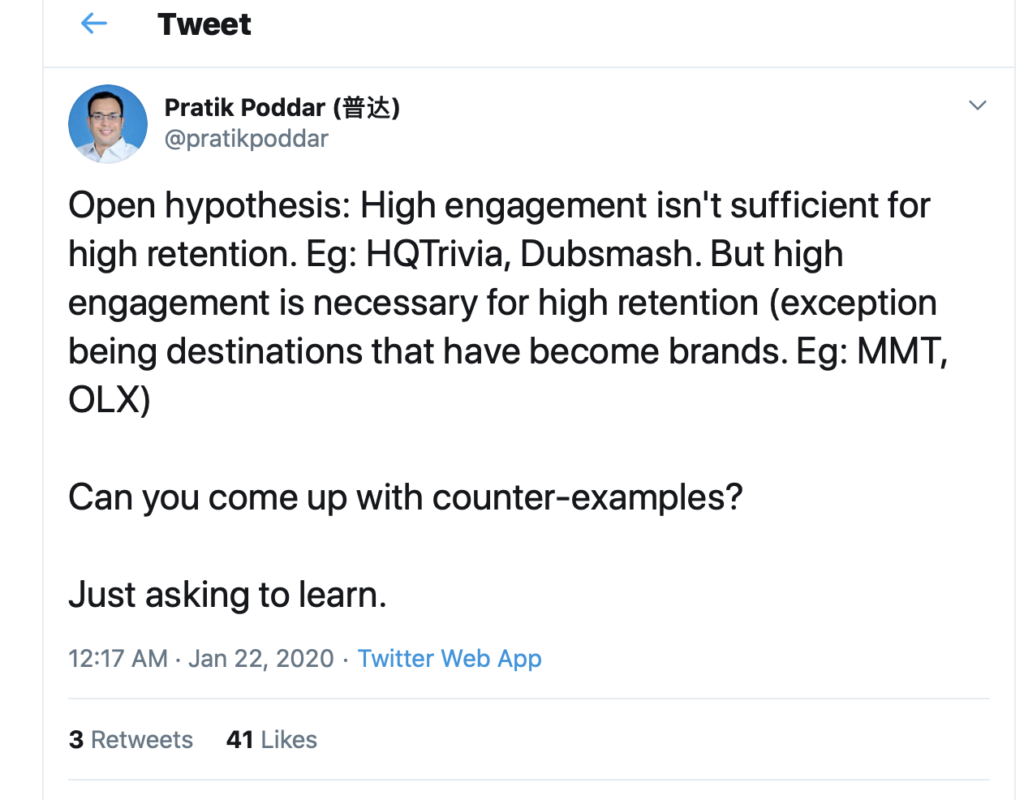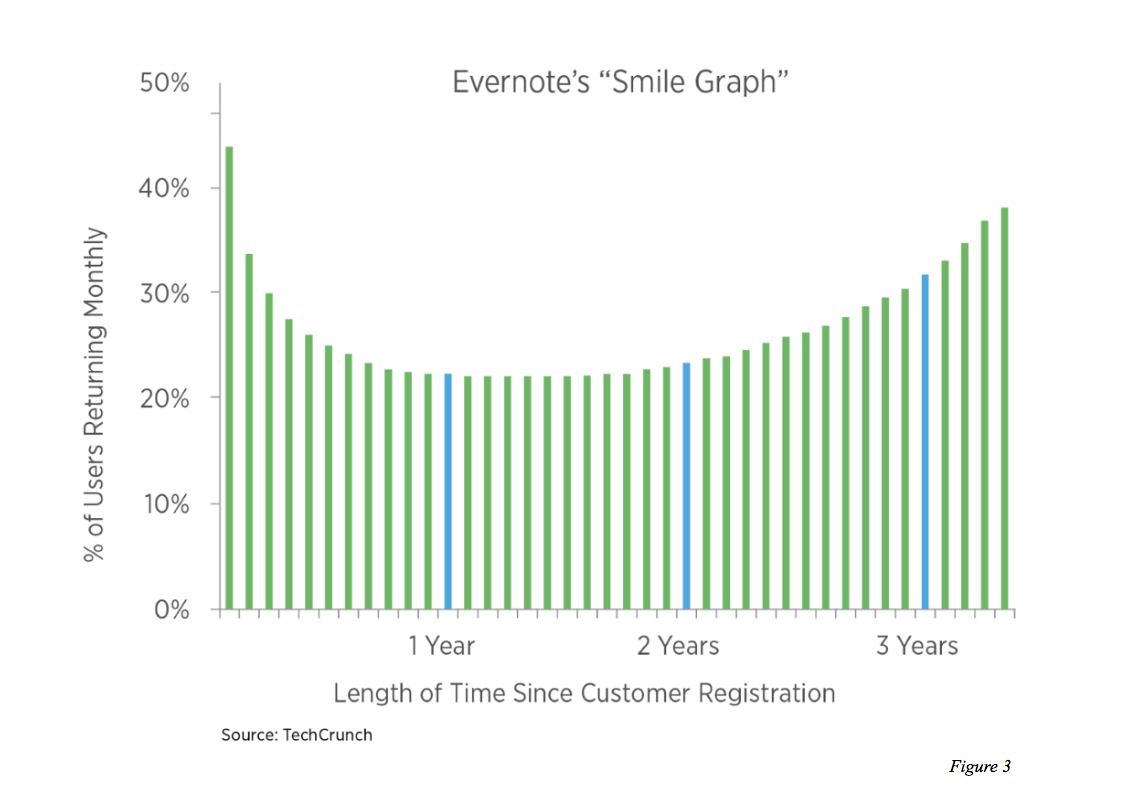The trigger for this post was this interesting tweet

An inquiry into this question leads to a perspective on how to view engagement for your product. This perspective will help you decide your engagement and retention strategy effectively.
To dig deeper, let’s start by classifying various products into categories
- Utility/Productivity
- News & Entertainment (Video, Audio, Text)
- Messaging, Social Media & Gaming
- Transactional/E-commerce & Payments
I’ve tried to club all apps into these four broad categories for simplification. Now you have to identify in which category does your product fall under.
Let’s consider some examples mentioned in the discussion on the tweet above and map them to categories

By virtue of the category to which your product belongs there will be a potential engagement frequency for it.
Potential Engagement Frequency: Number of times a product can be used over a period of time.

* This frequency is for usage of the core product functionality, the same can be increased by adding more features.
Is High Engagement a necessary but not sufficient condition for Retention?
Not really. While Engagement is strongly correlated with Retention, neither is it necessary for nor does it guarantee Retention.
To understand why that’s the case let’s try to list down other Influencing Factors that impact engagement and retention across products
- Needs – Jobs to be done
- Trends – Shiny new things
- Incentives – Offers, rewards and such
- Distribution advantage – Availability of good alternatives, network effects
If you look at any product from these two lenses (categories and influencing factors) you would be able to understand if/where does engagement results in retention and where it doesn’t.
Note: Retention is significantly dependent on the products ability to reliably deliver on the core needs and its stickiness
- Utility/Productivity – For this category engagement could be a function of frequency of the need and retention would be a function of how much stickiness can the product build (through data, learning curve etc).
Some apps I use are Evernote, Myfitnesspal and Shazam. I’ve been using these three apps (with varying levels of engagement) for at least three years. While I use Evernote almost daily, I use Myfitness pal weekly when I’m tracking my weight and it’ll sit unused for months when I don’t track my weight.
In many such cases retention comes because the effort to learn how a new app isn’t worth the marginal improvement you’ll get.

However, in some cases where the the single player mode isn’t that strong, you’ll have to build engagement around other features to ensure top of mind recall and retention - News & Entertainment (Video, Audio, Text) – For this category engagement could be a good indicator of retention as users one used to a platform don’t tend to change as much as long as content quality is maintained and new content (user generated or otherwise) keeps getting added.
The exceptions could be some paradigm shifts (like storage to streaming or desktop to mobile) or loosening of distribution advantage (people might be engaging actively with proprietary apps on an OS but that could change quickly if other apps surface) but the shift would be gradual so it can be picked - Messaging, Social Media & Gaming – For this category engagement could be a function of trends and retention could be a function of trends, needs (vs wants) and distribution advantage. Games have the highest 30 day retention among all categories (so definitely more engagement). While Games are particularly prone to change of trend cycles, everyone is familiar about how network effects if working in other direction (or Eflactem’s Law as it’s called) can sink a social media company. More on this here.
One of the biggest examples was a viral apps called Yo. For those who don’t know about Yo, it was a one tap, one messaging app through which users could send a ‘Yo’ to their friends, who could then reply back with a guess what? (Yo). It had great engagement (over 1.2 mn DAUs at one time) for a few days/weeks that people used it but that engagement never translated into retention.
The task at hand for games is translate high engagement into stickiness by means such as virtual goods, avatars and such to avoid change of seasons churn and for social networks it is to improve engagement and try to convert that into network effects (while improving the product and increasing its scope for potential users)

4. Transactional/E-commerce & Payments – For this category engagement could be a
function of frequency of need and incentives and retention could be a function of
consistency of experience. Here figuring out the ‘Potential Engagement Frequency‘
and % adoption from that is a good measure. For ex: Uber measures and tries to
improve their share of airport rides (to departure airport and subsequently from the
arrival airport).
For a flight or a hotel booking site say the average user does a transaction after every
3-6 months or more. One way to approach retention for such cases is to see
what’s the average usage frequency of the user and if that’s increased or maintained.
A drop in previous levels of engagement could be a sign of churn. Also, an drop in
funnel conversion rates for a user should be worrying (For ex: Uber on basis of my
rides data might think I take cabs once a week only but if I check for a ride more often
but book only once a week, perhaps my potential engagement frequency is higher and
they should try to improve my engagement per week.
Here an engagement (non incentive driven) is a good indicator of retention.
Another product that I like but use once a year or so is Cashify. The app does the job
well but it’s not a frequent use case so they have to look at retention over a slightly
long period as compared to say an Ecommerce store. They can however try to get their
users who’ve finished a transaction to refer more users.
Key Takeaways:
- Identify your product’s category its potential engagement frequency (PEF).
- Understand which factors can influence engagement for your product.
External (trends, wants, temporary distribution edge) or internal (needs, network effect, stickiness) - For Engagement: First focus on internal influencing factors (strengthening core use case experience, data moats, network effects etc) and build on them. In case of low PEF try to increase referrals.
- For Retention: Divide users into cohorts basis their engagement wrt the PEF, monitor and encourage their engagement accordingly.
Try to understand reasons for drop in engagement and fix them through the product as much as possible (product improvement over incentives)
This Point of view (categories and influencing factors) would help us in figuring out how to look at engagement and retention better. Would love to know what do you think?
Credits: Thanks to Navneet Singh for reading the draft and sharing feedback
I run a weekly newsletter in which I share curated articles, podcasts, videos and books I came across and loved. You can subscribe to it here


